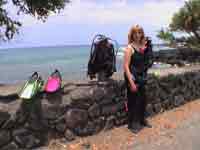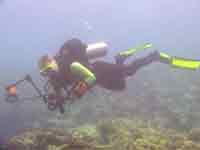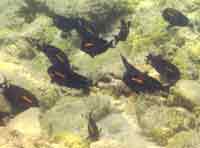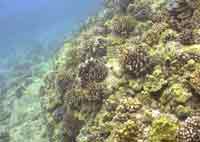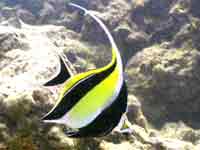 |
||||||||||||||||||||||
Well, today is a great day! Sunshine and no rain! The sea is calm, so it's a good day to go diving! The Kona coast has some of the best diving in the Hawaiian islands so we will see what we can find underwater here. Our first scuba dive will be on the beach about 2 miles south of Kailua-Kona. We stop our SUV along the side of the road next to a short wall made of lava rock. We unload all our dive equipment and start putting on our dive gear. With all our dive gear on, except our fins, we carefully walk down to the beach just below us. The beach is very rocky, but fortunately there is no surf here. We step around and over the rocks into the water. When we get to waist-deep water we put on our fins. Then, holding our cameras, we lay down in the water and swim away from the beach into deeper water. The water is fairly clear here. We can see about 50 feet away. Underwater we see large and small volcanic rocks covered with algae. We see some small patches of coral, too. Small schools of algae-eating fish swim by, stopping occasionally to nibble on the algae. As we get further from shore the water gets clearer. Now we can see about 60 feet away. The rocky reef here has more coral and less algae. We see more fish, too. We are surprised at the amount of coral we see here. Hard corals only survive in water that is 78-84ºF. If the water is too hot or too cold the corals can die. Even though the water in Hawaii is very warm, sometimes the temperature can drop below 78ºF. Because of this we didn't expect to see many corals. Even though we do see many corals they are small and we only see a few kinds. The corals here are not as large and there are not as many different kinds as we have seen in the Caribbean Sea. The corals here appear surprisingly healthy. We do see some dead patches of corals, but mostly the corals are doing fine. As we would expect with a healthy reef we see a good variety of fish life. We see algae-eating surgeonfishes and Hawaiian sargent majors, fish-eating mackerel and trumpetfish, worm-eating butterflyfishes and wrasses, and coral-eating parrotfishes. We don't see any big fish. Most of the fish we see are between 3-10 inches long. We are looking for large sea anemones because they would could be a home for clownfish, like Nemo. We do not see any sea anemones or clownfish. We do see one of Nemo's friends, though. If you saw the movie Finding Nemo the fish that was the leader in the aquarium was a Moorish Idol, named Gill. Swimming around us is a Moorish Idol, like Gill! The Moorish Idol is a medium sized fish about 8-10 inches long. It is a pretty fish with bold, yellow-white and black stripes up and down on its body. These stripes are a kind of camouflage. The stripes help this fish blend into the dark shadows around the reef. The front stripes also cover its eyes, so predators that would like to eat it will be confused about which end is the front. This way the predators won't be sure if they are sneaking in from behind the fish or not! We see we are getting low on air, so it's time for us to swim back to the beach and get out of the water. We have been surprised to see more coral than we expected. In some places the corals look very healthy. We saw that there are many algae-eating fish here that can keep the algae here from growing up and smothering the coarls. We did not see any clownfish, though. We will be looking for clownfish tomorrow on our next dive, too. Tomorrow there will be no beach where we can enter the water like today, so we will be diving from a boat. Join us tomorrow as we continue our explorations of' the underwater world of Hawaii's Kona coast. Best Fishes, |
TODAY'S DATA Kailua-Kona, Hawaii Position: 19º 38' N / 155º 59' W Karen is getting ready to go scuba diving. You can see the Pacific Ocean behind this lava rock wall.
Wayne is taking pictures with his underwater camera. You can see the rocks below him are mostly covered with algae.
We found this small school eating the algae on the rocks. These fish are called Achilles Tangs. They are about 8 inches long.
In the deeper water we see that the lava rock reef is covered with patches of small corals.
This is Nemo's friend, Gill, from the aquarium in Finding Nemo. This fish is a Moorish Idol about 8 inches long. |
|||||||||||||||||||||
home | basecamp | archives | library | other expeditions | kids' page | contact us © 2003, The Ocean Adventure All rights reserved. |
